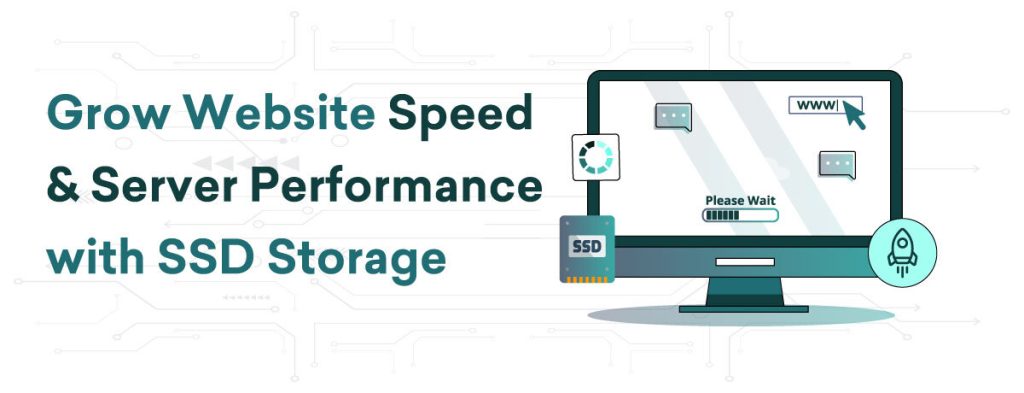Grow Website Speed & Server Performance with SSD Storage

In the age of modern technology, a website’s speed is essential for providing a seamless user experience, raising its search engine ranks, and winning over more customers. The kind of storage that the server uses plays a major role in influencing how fast a website loads. Solid State Drive (SSD) storage is one of the best solutions for storage that cloud computing offers. SSDs (solid state drives) are a popular option for cloud hosting websites due to their speedier performance as compared to regular HDD (hard disk drive) storage. This post will explain what SSD storage is, how it helps cloud computing servers, and how it can dramatically increase website speed.
What Is SSD Storage?
SSD (Solid State Drive) storage is a type of data storage device that uses flash memory to store data. Unlike HDDs, which have spinning disks to read and write data, SSDs have no moving parts, making them faster and more reliable. They are known for their superior speed, durability, and energy efficiency, which makes them ideal for cloud servers and website hosting.
How SSD Storage Works
SSDs use NAND flash memory cells to store data. When a user requests information from a website or application hosted on a server with SSD Storage, the SSD retrieves the data almost instantly. The absence of mechanical parts means that data can be accessed faster than with HDDs, where the spinning disks need to locate the data before retrieving it.
Benefits of SSD Storage for Cloud Servers
Cloud computing relies on powerful servers to store and process data for businesses and users worldwide. Here’s how SSD storage benefits cloud servers:
Faster Data Access: SSDs offer significantly faster data access times compared to HDDs. This speed is critical for cloud servers, as they are responsible for handling numerous requests from users in real time. Faster data access means quicker processing of these requests, leading to a more responsive server.
Improved Reliability: Since SSDs have no moving parts, they are less prone to physical damage or mechanical failure. This makes them more reliable than HDDs, which can wear out over time. Cloud providers that use SSD storage can offer more consistent performance and reduce the risk of server downtime.
Energy Efficiency: SSDs consume less power than HDDs, making them an energy-efficient option for cloud data centers. This not only reduces the environmental impact of cloud services but also helps businesses save on energy costs when using cloud servers with SSD storage.
Better Scalability: SSDs allow cloud providers to scale resources more effectively. Whether a business needs more storage or faster processing power, SSD storage can easily accommodate these needs, ensuring smooth performance as a business grows.
Enhanced Security: SSDs offer better security features, such as data encryption, which is essential for businesses handling sensitive information. Cloud providers with SSD storage can offer enhanced data protection, reducing the risk of data breaches and cyberattacks.
How SSD Storage Improves Website Speed
Website speed is a critical factor in user experience. A slow website can lead to higher bounce rates, lower conversions, and decreased customer satisfaction. Here’s how SSD storage can help improve website speed:
Faster Loading Times: SSDs can read and write data much faster than HDDs. When a user visits a website hosted on an SSD-based server, the server can quickly retrieve the necessary files and data, leading to faster loading times. This is especially important for websites with high traffic or complex content, such as e-commerce stores or media-rich platforms.
Improved Performance Under Load: Websites with high traffic or multiple users accessing them simultaneously can experience slower speeds with traditional HDDs. SSDs, however, handle multiple requests more efficiently, ensuring that the website maintains fast performance even during peak traffic times.
Reduced Latency: Latency refers to the time it takes for a server to respond to a user’s request. With SSD storage, latency is significantly reduced because data is accessed almost instantly. This means that users experience quicker responses when navigating through a website or loading pages.
Enhanced User Experience: A fast website enhances user experience, making it more likely that visitors will stay longer and engage with the content. Whether browsing a blog, shopping on an online store, or interacting with a web app, SSD storage ensures a seamless experience by minimizing delays and lag.
SEO Benefits: Search engines like Google consider website speed as a ranking factor. Faster websites tend to rank higher in search engine results, driving more organic traffic. By using SSD storage, businesses can improve their website speed and, as a result, potentially boost their SEO performance.
Improved Mobile Experience: Many users access websites through mobile devices. SSD storage ensures that websites load quickly on both desktop and mobile platforms, providing a consistent experience across all devices. This is crucial for businesses that want to reach a broader audience and improve mobile engagement.
How to Implement SSD Storage for Your Website
Monitor Performance: Regularly monitor your website’s performance using tools like Google PageSpeed Insights or GTmetrix. This will help you track speed improvements and identify areas where optimization may still be needed.
Optimize Your Website: Along with using SSD storage, optimizing your website by compressing images, minifying code, and using caching can further improve speed and performance.
Conclusion
SSD storage in cloud computing offers a powerful solution for businesses looking to enhance their server performance and improve website speed. With faster data access, increased reliability, and energy efficiency, SSDs provide numerous benefits over traditional HDDs. For websites, SSD storage can lead to faster loading times, better performance under load, and an overall improved user experience. By leveraging SSD storage in the cloud, businesses can ensure their websites are fast, responsive, and ready to handle the demands of today’s digital users.